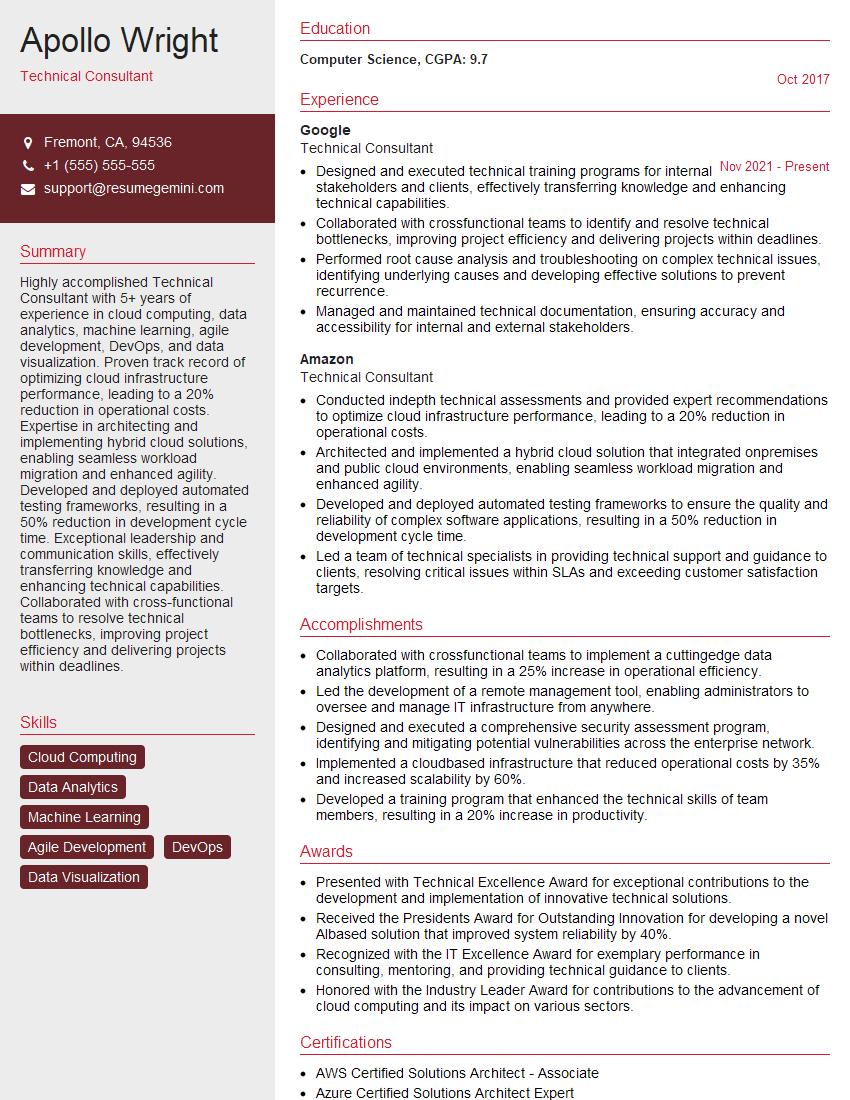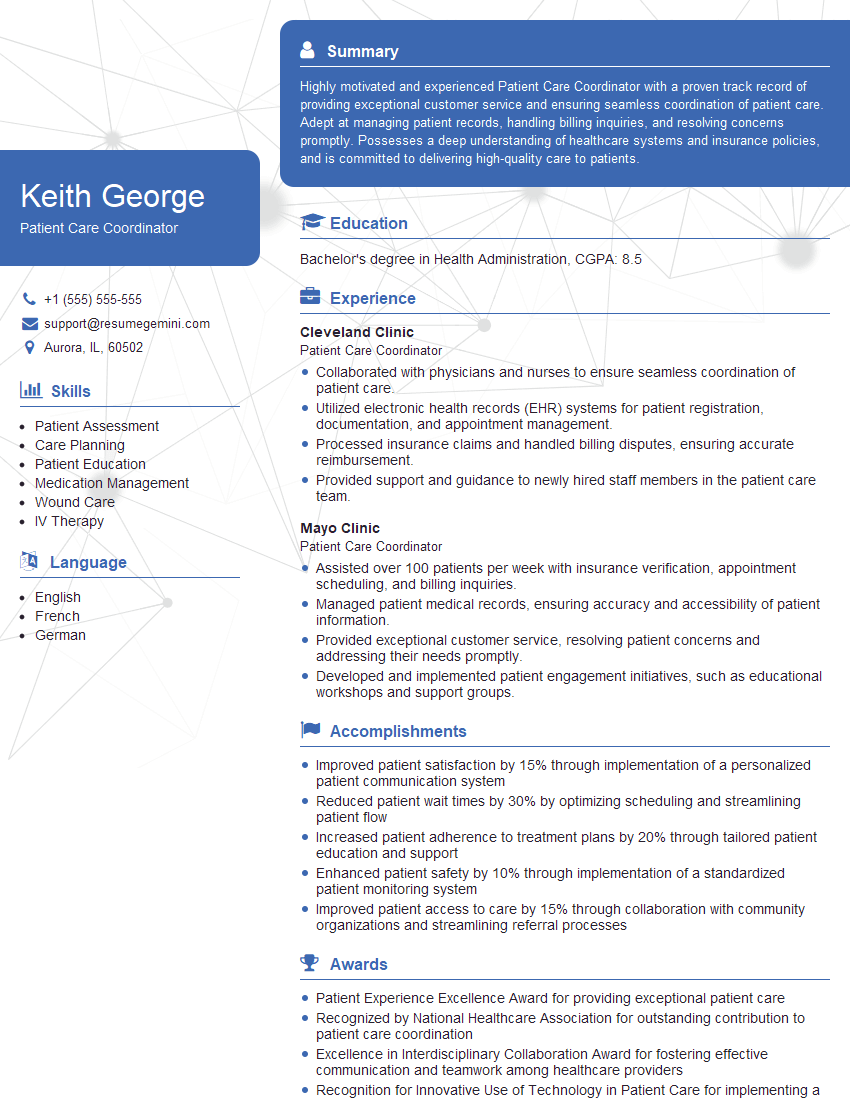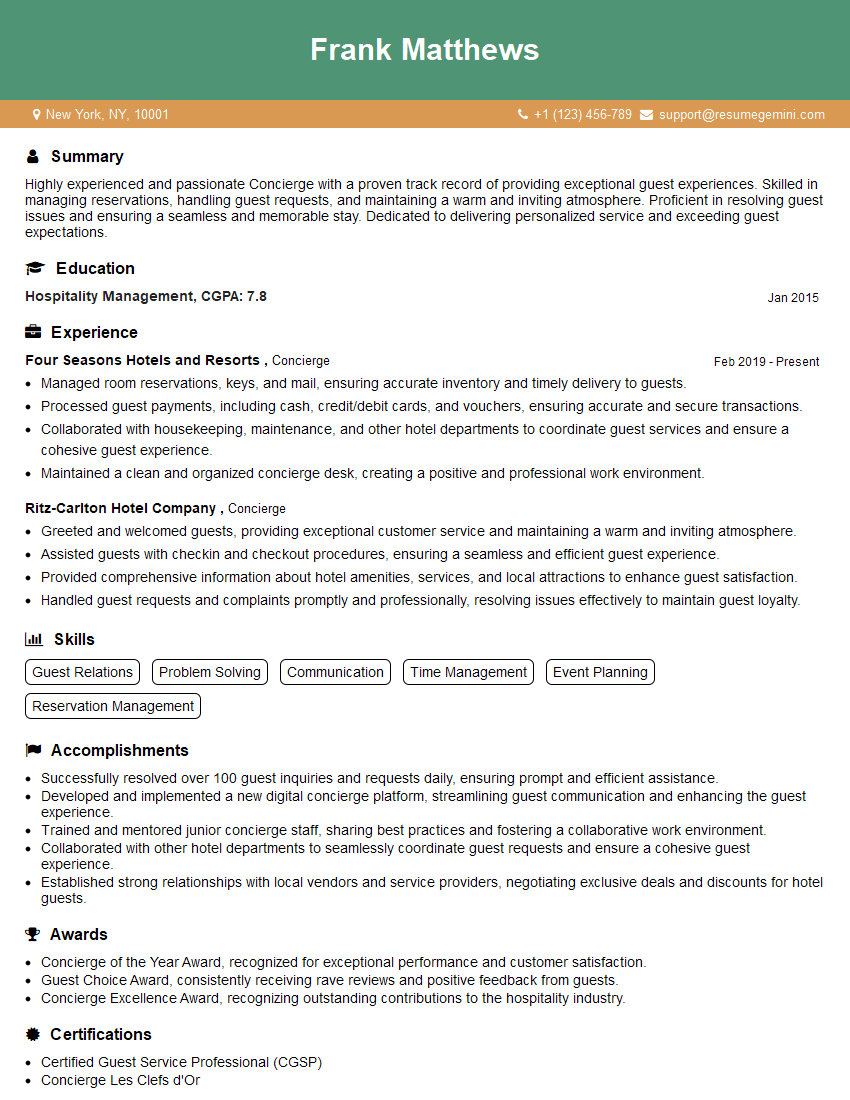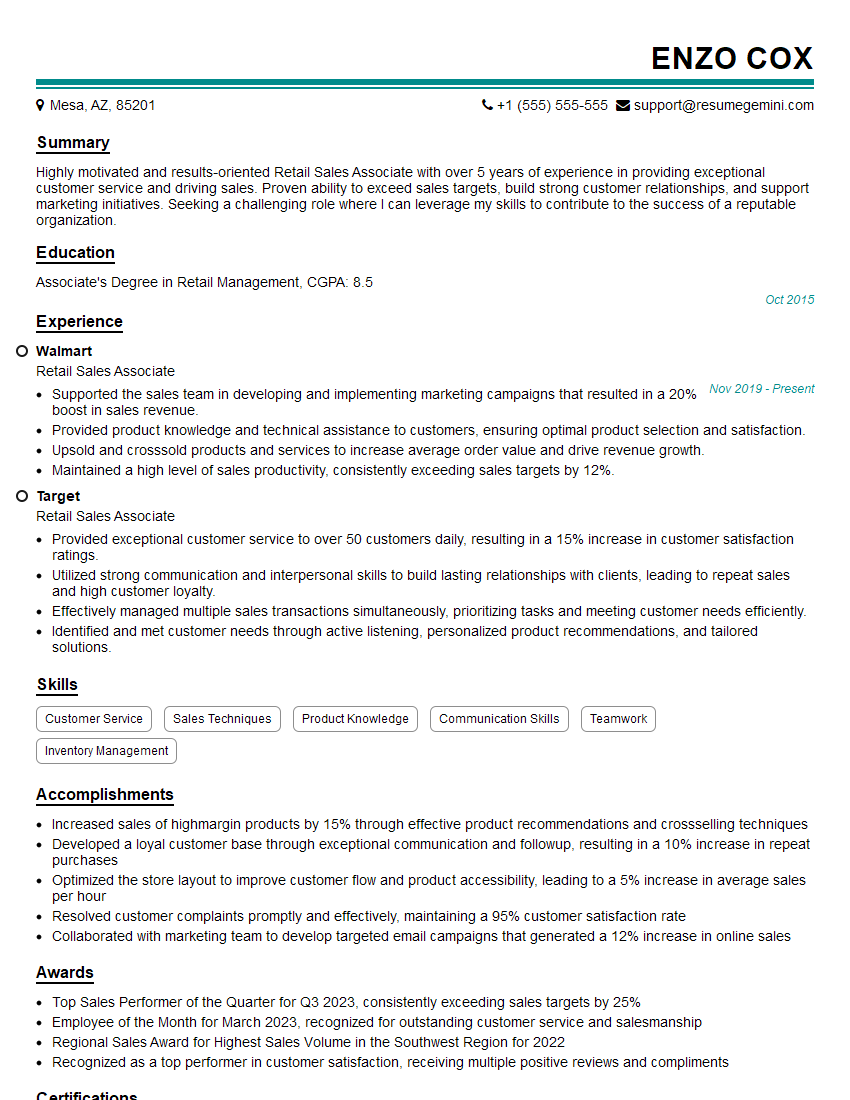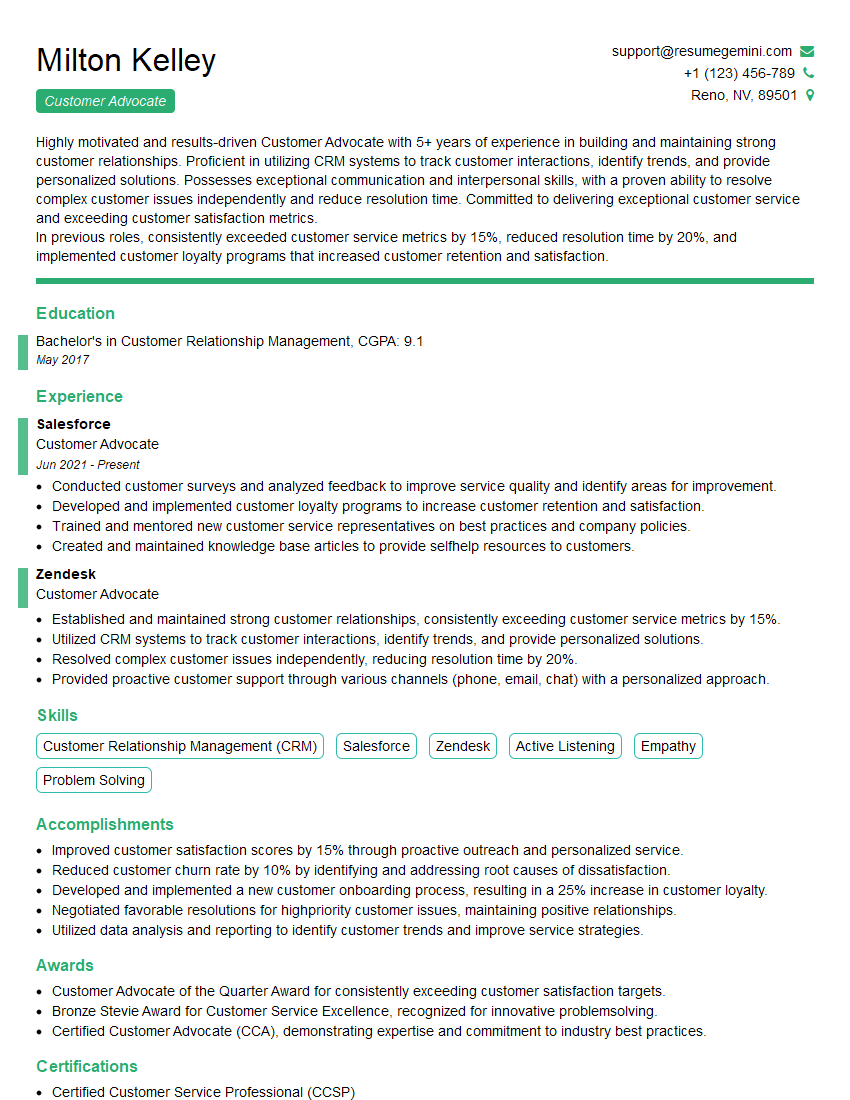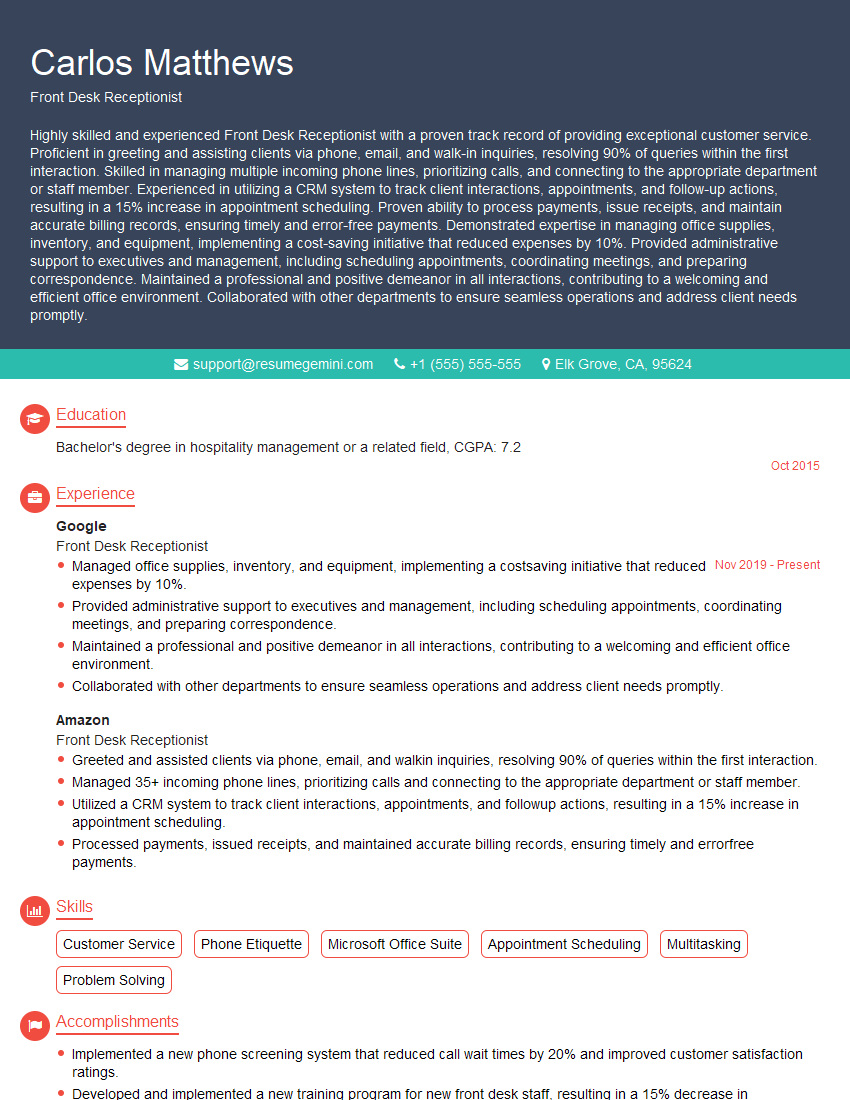Feeling uncertain about what to expect in your upcoming interview? We’ve got you covered! This blog highlights the most important Ability to Provide Customer Service and Advice interview questions and provides actionable advice to help you stand out as the ideal candidate. Let’s pave the way for your success.
Questions Asked in Ability to Provide Customer Service and Advice Interview
Q 1. Describe your approach to handling a highly irate customer.
My approach to handling a highly irate customer centers around empathy, active listening, and a calm, controlled demeanor. The goal isn’t to win an argument, but to de-escalate the situation and find a resolution. I start by letting the customer vent without interruption, demonstrating that I’m truly hearing their frustration. Once they’ve had their say, I use active listening techniques – paraphrasing their concerns to show understanding and validating their feelings. For example, I might say something like, ‘So, it sounds like you’re incredibly frustrated because of X, and you feel Y.’ This validates their emotions without necessarily agreeing with their assessment of the situation. Then, I move into problem-solving, outlining concrete steps I can take to address their concerns. If I can’t immediately resolve the issue, I’ll clearly outline a timeline for a solution and keep them updated along the way. Throughout the interaction, maintaining a respectful and calm tone is crucial, even if the customer isn’t reciprocating. This shows professionalism and helps de-escalate the tension. Finally, I aim for a mutually agreeable resolution, offering sincere apologies where appropriate, even if the fault isn’t entirely ours.
For instance, I once dealt with a customer whose order was delayed due to unforeseen logistical issues. He was understandably furious. I let him express his anger, then acknowledged his frustration and explained the situation clearly, offering a full refund and expedited shipping on a replacement order. This proactive approach, combined with empathetic listening, helped turn his anger into satisfaction.
Q 2. How do you prioritize multiple customer requests simultaneously?
Prioritizing multiple customer requests involves a combination of urgency, importance, and efficiency. I use a system that considers the impact of each request. I typically utilize a prioritization matrix, mentally weighing factors like deadlines, customer impact, and potential consequences of delay. Requests requiring immediate attention, such as a critical system failure affecting many users, are prioritized over less urgent tasks. I might use a simple numbering system (1-5, 1 being highest priority) or even a simple to-do list organized by priority. This helps me stay organized and manage my workload effectively.
For example, if I receive a call from a customer experiencing a service outage alongside a series of emails requiring information and a scheduled webinar prep, the service outage receives immediate attention. I might briefly acknowledge the email requests, setting aside time blocks later to address them systematically. The webinar prep, while important, is planned and therefore can be scheduled accordingly. Multitasking is possible but requires careful planning and focused bursts of work to prevent errors and burnout. I find short bursts of focused attention to be more effective than attempting to handle everything simultaneously.
Q 3. Explain a time you had to deliver difficult news to a customer.
I once had to deliver the news that a customer’s long-awaited product was discontinued due to unforeseen circumstances related to supply chain issues. This was particularly challenging as the customer had been eagerly anticipating this product for months and had already made significant arrangements around its arrival. My approach was to be direct, yet empathetic. I didn’t sugarcoat the news, but I carefully explained the reasons for the discontinuation, acknowledging the disappointment it would cause. I then proactively explored alternative solutions, such as offering a comparable product or a full refund with a generous discount on future purchases. I prioritized making sure they understood why the product wasn’t available, and what options were available to them as an alternative, and I communicated with empathy and sincerity. This helped to mitigate their frustration and foster goodwill.
Q 4. How do you adapt your communication style to different customer personalities?
Adapting my communication style involves understanding and responding to different customer personalities. Some customers prefer concise and direct communication, while others appreciate a more detailed and personable approach. I pay attention to verbal and nonverbal cues. For example, a customer who speaks rapidly and uses direct language might appreciate a similarly straightforward response. Conversely, a customer who speaks slowly and thoughtfully might benefit from a more detailed and patient explanation. I also adjust my tone to match the customer’s demeanor, maintaining a respectful and professional tone regardless of their approach. Being a good listener is key to picking up on these cues. Sometimes, a short, simple question like, “What is the best way for me to help you today?” can work wonders in adjusting your approach to the individual customer’s communication style.
For instance, I’ve learned that younger customers are often more comfortable with informal communication, whereas older customers may appreciate a more formal and respectful tone. Paying attention to these nuances allows me to tailor my communication to each individual and build better rapport.
Q 5. How do you handle situations where you don’t have an immediate answer for a customer?
When I don’t have an immediate answer for a customer, honesty and transparency are paramount. I never try to fabricate an answer. Instead, I acknowledge that I don’t know the answer but will find out and get back to them promptly. I set clear expectations on the timeframe for providing the response, and I always follow through. This maintains trust and prevents customers from feeling ignored or misled. I might say something like, ‘I don’t have the answer to that right now, but I can look into it for you. I’ll get back to you within [timeframe].’ Often, I’ll ask for their contact information to ensure that I can update them in the most efficient way possible. I will then document the question and the appropriate steps needed to find an answer and begin to find the answer as soon as possible. Following up promptly is very important in this situation.
Q 6. Describe your process for resolving customer complaints.
My process for resolving customer complaints follows a structured approach. First, I actively listen to the customer’s complaint, ensuring I fully understand their perspective. Then, I empathize with their frustration and validate their feelings. I avoid becoming defensive. Next, I gather all the necessary information to investigate the issue thoroughly. I take detailed notes, including timestamps and other relevant context. Once I understand the problem, I propose a solution, outlining the steps I’ll take to resolve the issue. This might involve making a repair, offering a refund, or providing a replacement. I keep the customer informed of my progress throughout the process. Finally, I follow up with the customer to ensure their satisfaction with the resolution. The whole process is documented meticulously for future reference and to track complaint trends that can be addressed in the long run. A good resolution frequently involves offering compensation beyond just fixing the problem as a token of good faith.
Q 7. What strategies do you use to build rapport with customers?
Building rapport with customers involves creating a positive and trusting relationship. I achieve this by demonstrating genuine empathy, actively listening to their concerns, and making a sincere effort to understand their perspective. I start by using their name and addressing them respectfully. I ask open-ended questions to show genuine interest in what they have to say and to get to the bottom of their needs in a thorough manner. I also take the opportunity to share relevant information and insights, making it clear that I value their business and their time. A little humor (if appropriate) can also help to break the ice. By being patient, understanding, and helpful, I can create a positive experience for the customer that fosters loyalty. Simple things like being aware of their time constraints and ensuring a timely resolution all contribute to building a good relationship.
For example, a simple ‘How was your day?’ before getting down to business can show the customer that you’re not just there to perform a job and that you care about them as an individual. This human connection is often what turns a simple interaction into a strong positive relationship with a customer.
Q 8. How do you identify and address the root cause of a recurring customer problem?
Identifying and addressing the root cause of a recurring customer problem requires a systematic approach. It’s not enough to simply solve the immediate issue; we need to prevent it from happening again. Think of it like a detective investigating a crime – we need to gather clues and build a case.
- Gather Data: The first step is to collect information. This includes details about the problem itself (what, when, where), the customer’s actions leading up to the problem, and any error messages or logs. For example, if multiple customers are reporting website crashes, I’d note the time of day, browser versions, and any error codes.
- Analyze Patterns: Once we have enough data, we analyze for patterns. Are there common factors among affected customers? Is the problem linked to a specific feature, time of day, or operating system? In the website crash example, noticing that all crashes occur during peak hours might suggest a server overload.
- Identify the Root Cause: Based on the patterns, we hypothesize the root cause. Is it a software bug? A hardware limitation? A lack of training? In the website crash scenario, the root cause might be insufficient server capacity.
- Implement a Solution: Once we’ve identified the root cause, we implement a solution to prevent recurrence. This could involve fixing a bug, upgrading hardware, or providing additional training. For our website example, solutions could include upgrading server hardware or optimizing the website’s code to improve efficiency.
- Monitor and Refine: Finally, we monitor the situation after implementing the solution to ensure the problem is truly resolved. If the problem persists, we re-evaluate our approach and refine our solution.
This systematic approach ensures that we address not just the symptoms, but the underlying cause, leading to more effective and sustainable solutions.
Q 9. Explain a time you went above and beyond to help a customer.
In my previous role, a long-term customer, a small bakery owner, experienced a critical equipment malfunction just before a large order deadline. Their oven, crucial for their business, stopped working completely. While technically outside the scope of our usual support, I understood the urgency and the potential financial impact on their small business.
I went beyond the standard troubleshooting steps. I spent extra time on the phone, patiently guiding them through basic checks, and even researching local appliance repair services, personally calling several until I found one available that day. I then coordinated with the repair service, providing them with the necessary information to quickly diagnose and fix the oven. The bakery met their deadline, and the owner was incredibly grateful. The appreciation I received reinforced that going the extra mile is not just about customer satisfaction, but also about building strong, trusting relationships.
Q 10. How do you handle conflicting priorities between customer needs and company policies?
Handling conflicting priorities between customer needs and company policies requires a delicate balance of empathy and firm adherence to established guidelines. The key is clear communication and finding creative solutions.
- Understand Both Sides: First, I thoroughly understand both the customer’s needs and the relevant company policies. I aim to see the situation from both perspectives.
- Communicate Empathetically: I acknowledge the customer’s frustration and explain the company’s policy clearly, but without being dismissive or defensive. Emphasizing shared goals is crucial.
- Explore Alternatives: I actively seek mutually agreeable solutions. Could a compromise be reached? Are there any exceptions to the policy that could apply? Sometimes, even a small gesture of goodwill can greatly improve the customer’s experience.
- Escalate When Necessary: If a compromise can’t be reached, I escalate the issue to my supervisor to explore options beyond my immediate authority. Transparency is critical.
- Document Everything: Detailed documentation protects both the customer and the company. This ensures accountability and enables better handling of similar situations in the future.
Ultimately, I aim for a solution that is fair to both the customer and the company, while adhering to ethical principles and maintaining positive relationships.
Q 11. How do you stay calm and professional under pressure?
Staying calm and professional under pressure is a vital skill in customer service. It’s like being a calm harbor in a storm for the customer.
- Deep Breaths: Taking a few deep breaths helps regulate my physiological response to stress.
- Active Listening: Focusing on what the customer is saying helps me understand their concerns and defuse anger through genuine empathy.
- Positive Self-Talk: I remind myself that I have the skills and knowledge to handle the situation effectively. Positive self-talk boosts confidence.
- Structured Approach: Following a systematic problem-solving process maintains control and helps me approach the situation methodically.
- Set Realistic Expectations: I don’t promise unrealistic outcomes. Managing expectations reduces the potential for further frustration.
By employing these strategies, I can remain calm, professional, and effective even in challenging situations, allowing me to provide helpful support to customers.
Q 12. How do you measure the effectiveness of your customer service interactions?
Measuring the effectiveness of customer service interactions goes beyond just resolving immediate issues. It’s about assessing the long-term impact on customer satisfaction and loyalty. I use several methods:
- Customer Satisfaction Surveys: Post-interaction surveys gather feedback on the quality of service, resolution speed, and overall experience. These provide quantifiable data.
- Resolution Rates: Tracking the number of resolved issues versus unresolved issues indicates efficiency and problem-solving abilities.
- Customer Retention Rates: This metric reflects the overall success of customer service efforts in fostering long-term relationships. High retention indicates effective customer service.
- Net Promoter Score (NPS): This metric measures customer loyalty and willingness to recommend the company to others, providing a broader measure of overall satisfaction.
- Call Recording and Review: Reviewing recordings can identify areas for improvement in communication skills, problem-solving techniques, and adherence to company policies.
By using a combination of quantitative and qualitative measures, I gain a comprehensive understanding of my performance and identify areas for continuous improvement.
Q 13. How do you provide clear and concise advice to customers?
Providing clear and concise advice involves effective communication techniques to ensure customers understand the information clearly and without unnecessary complexity.
- Plain Language: I avoid jargon and technical terms, opting for everyday language the customer can easily understand. I use analogies and metaphors to make complex information relatable.
- Structured Approach: I present information in a logical, step-by-step manner, breaking down complex issues into smaller, manageable parts. This helps customers follow the advice easily.
- Visual Aids: Where appropriate, I utilize visual aids like diagrams, flowcharts, or screenshots to clarify instructions or explain technical processes.
- Active Listening and Confirmation: I ensure the customer understands the advice by actively listening to their responses and confirming their comprehension through summarizing key points. I encourage them to ask clarifying questions.
- Concise Writing and Speaking: I avoid unnecessary details or rambling explanations, focusing on the key information needed to address the customer’s issue.
By employing these methods, I ensure the customer receives clear, concise, and actionable guidance that leads to a satisfactory resolution.
Q 14. What resources do you utilize to answer customer inquiries?
To answer customer inquiries accurately and efficiently, I utilize a variety of resources:
- Company Knowledge Base: This internal resource contains answers to frequently asked questions, troubleshooting guides, and product information. It’s my first point of reference for most issues.
- Product Documentation: Official product manuals, specifications, and user guides provide in-depth information about product features and functionality.
- Internal Communication Channels: I use instant messaging or email to consult with colleagues and subject matter experts when faced with complex or unfamiliar issues.
- External Resources: When necessary, I refer to reputable external sources such as industry websites, online forums, or trusted technical documentation to gather relevant information.
- Training Materials: Continuous professional development through company-provided training and self-learning keeps my knowledge up-to-date and helps me stay proficient with company products and services.
By utilizing these resources effectively, I can consistently provide accurate and helpful information to customers, ensuring a high-quality customer service experience.
Q 15. Describe a time you received constructive criticism on your customer service skills. How did you respond?
Constructive criticism is invaluable for professional growth. In my previous role at a tech support company, a supervisor noted that while I was technically proficient, I sometimes came across as overly formal and less empathetic in my initial interactions with frustrated customers. Instead of defensiveness, I welcomed this feedback. I realized that my focus on technical solutions overshadowed the importance of acknowledging the customer’s emotional state. My response was two-fold: first, I actively worked on incorporating more empathetic language, using phrases like “I understand your frustration” and “Let’s work together to solve this.” Second, I observed colleagues known for their excellent rapport with customers, analyzing how they built connections. I consciously adopted some of their communication techniques, such as actively listening and reflecting their concerns before offering solutions. This led to improved customer satisfaction ratings and stronger relationships.
Career Expert Tips:
- Ace those interviews! Prepare effectively by reviewing the Top 50 Most Common Interview Questions on ResumeGemini.
- Navigate your job search with confidence! Explore a wide range of Career Tips on ResumeGemini. Learn about common challenges and recommendations to overcome them.
- Craft the perfect resume! Master the Art of Resume Writing with ResumeGemini’s guide. Showcase your unique qualifications and achievements effectively.
- Don’t miss out on holiday savings! Build your dream resume with ResumeGemini’s ATS optimized templates.
Q 16. How do you handle customers with unrealistic expectations?
Handling customers with unrealistic expectations requires a delicate balance of empathy and firmness. The key is to validate their feelings while setting clear boundaries and managing their expectations. I typically start by actively listening to their concerns and acknowledging their perspective. For instance, if a customer demands an impossible refund or turnaround time, I might say something like, “I understand you’re looking for [their desired outcome], and I want to help. Let’s explore what we can realistically achieve within our policy and available resources.” Then, I clearly explain the limitations and offer alternative solutions that are feasible and still beneficial to the customer. This approach often involves outlining the steps involved, the timelines, and the potential outcomes. Transparency and proactive communication are crucial in managing expectations. Ultimately, the goal is to find a solution that meets the customer’s needs as much as possible within the constraints of the business.
Q 17. Describe a situation where you had to escalate a customer issue. What steps did you take?
Escalating a customer issue requires a methodical approach to ensure a fair and effective resolution. I once had a customer who experienced a critical software bug resulting in significant data loss. After exhausting all first-line support options (troubleshooting, applying known fixes), I knew escalation was necessary. My steps involved: 1) Thorough Documentation: I meticulously documented every interaction with the customer, including timestamps, solutions attempted, and the customer’s feedback. 2) Clear Communication: I prepared a concise summary of the issue, outlining the steps taken, the customer’s impact, and the urgency of the situation. 3) Appropriate Escalation Channel: I followed the established protocol, escalating the issue to the relevant technical team via our ticketing system (using a predefined escalation template). 4) Keeping the Customer Informed: I kept the customer informed every step of the way, providing regular updates on the progress of the escalation. This maintained transparency and built trust. The issue was successfully resolved by the development team, and the customer was incredibly grateful for the prompt attention and resolution.
Q 18. How do you ensure customer satisfaction in a fast-paced environment?
Maintaining customer satisfaction in a fast-paced environment necessitates efficiency and effective prioritization. My strategy involves using time management techniques like prioritizing urgent issues and utilizing efficient communication channels like email templates and quick response guides for common queries. Multitasking efficiently and using CRM systems to track customer interactions and their history is essential. I also proactively anticipate potential issues by regularly monitoring system performance and making sure that frequently asked questions are easily accessible. Building rapport quickly and creating a sense of personalized attention, even amidst the fast pace, is essential. Sometimes a simple, “I understand you’re in a hurry, let’s get this sorted for you quickly” can make all the difference.
Q 19. What are your strengths and weaknesses in providing customer service and advice?
My strengths lie in my ability to actively listen, empathize with customers, and find creative solutions to complex problems. I’m adept at building rapport quickly and maintaining a calm and professional demeanor, even under pressure. I’m also proficient in utilizing various CRM and ticketing systems to manage customer interactions efficiently. However, a weakness I acknowledge is the occasional tendency to overcommit to resolving issues quickly. I’m actively working on setting realistic expectations and prioritizing tasks more effectively to avoid burnout and ensure the highest quality of service.
Q 20. How do you proactively identify and prevent potential customer issues?
Proactive issue prevention is crucial for excellent customer service. This involves regularly analyzing customer feedback, identifying recurring issues or pain points, and proactively addressing them. For example, if I notice many customers struggling with a particular feature in our software, I’d investigate whether updated documentation, a tutorial video, or an FAQ would be beneficial. Regularly reviewing system logs, monitoring user behavior, and using data analytics to spot trends can also help. Furthermore, staying updated on industry best practices and technological advancements allows for anticipating potential issues before they impact customers. A proactive approach prevents problems before they escalate, fostering customer loyalty and reducing support costs.
Q 21. How familiar are you with different customer service methodologies (e.g., CRM, ticketing systems)?
I’m highly familiar with various customer service methodologies and tools. My experience includes extensive use of CRM systems such as Salesforce and HubSpot, allowing me to manage customer interactions, track communication history, and analyze customer data for improved service. I’m also proficient in utilizing ticketing systems like Zendesk and Jira Service Desk for efficient case management and tracking. I understand the importance of using these tools to streamline workflows, improve collaboration, and enhance overall customer satisfaction. Beyond software, I’m also versed in various customer service philosophies, such as the customer-centric approach and the importance of continuous improvement.
Q 22. How do you maintain confidentiality when dealing with sensitive customer information?
Maintaining confidentiality with sensitive customer information is paramount. It’s not just about following company policy; it’s about building trust and upholding ethical responsibilities. My approach is multi-faceted.
- Strict adherence to company policy: I familiarize myself thoroughly with all relevant data privacy policies and regulations, such as GDPR or HIPAA, depending on the industry and location. I understand what information is considered sensitive and the protocols for accessing, storing, and disposing of it.
- Secure data handling: I never share sensitive information unless absolutely necessary and only with authorized personnel. I use secure systems for communication and data storage, and I always log out of systems properly. For example, I would never leave a customer’s file open on my computer if I stepped away from my desk.
- Need-to-know basis: I only access information that is relevant to the customer’s immediate needs. If I don’t need the information to resolve the customer’s issue, I won’t access it. This minimizes potential risks of breaches.
- Password protection and security awareness: Strong, unique passwords are crucial. I regularly update them and am vigilant about phishing attempts and other security threats. I participate in any security training provided by my employer.
- Data minimization: I collect only the necessary data required to deliver excellent service and avoid gathering excessive information.
For instance, if a customer calls about a billing query, I only access their billing information, not their entire profile. This limits exposure to sensitive data and reduces risk.
Q 23. How do you handle situations where a customer is being verbally abusive?
Handling verbally abusive customers requires a calm, professional, and empathetic approach. The goal is to de-escalate the situation and find a resolution, while also protecting myself and my colleagues.
- Remain calm and composed: Taking deep breaths and speaking calmly can prevent the situation from escalating further. Matching their aggression will only make things worse.
- Active listening and empathy: I try to understand the root cause of their anger, even if their delivery is unacceptable. Showing empathy by acknowledging their frustration, such as ‘I understand your frustration with this situation,’ can help.
- Set clear boundaries: It’s important to state firmly but respectfully that abusive behavior is unacceptable. For example, I might say, ‘While I want to help you, I cannot tolerate abusive language. Let’s try to discuss this calmly.’
- Document the interaction: I meticulously document the interaction, including the time, date, customer details, and a detailed summary of what happened. This record provides a reference point if further action is required.
- Seek assistance: If the situation cannot be resolved or becomes unsafe, I immediately seek assistance from a supervisor or security personnel.
Once the situation is de-escalated, I focus on resolving the customer’s issue to the best of my ability. Sometimes, simply taking the time to listen attentively and acknowledge their frustration can significantly improve the situation.
Q 24. What is your approach to learning new products or services to better assist customers?
Learning new products and services is an ongoing process. To effectively assist customers, I employ a multi-pronged approach.
- Formal training: I actively participate in any company-provided training programs on new products or services. These programs often include presentations, hands-on exercises, and quizzes to ensure complete understanding.
- Self-directed learning: I use the company’s internal resources such as wikis, knowledge bases, and training manuals to supplement formal training and deepen my understanding. I look for detailed specifications, tutorials, and FAQs.
- Practical application: I actively seek opportunities to use the new products or services in real-world situations, allowing me to build confidence and refine my knowledge. This can include shadowing more experienced colleagues or working on trial projects.
- Mentorship and collaboration: I don’t hesitate to reach out to colleagues with more expertise for clarification or guidance if I encounter any difficulties. Collaborating with others provides different perspectives and can enhance knowledge retention.
- Continuous feedback: I seek feedback from supervisors and colleagues on my performance in handling customers’ inquiries related to the new products or services to identify areas for improvement.
For example, if a new software feature is released, I would not just read the documentation; I’d try it out myself, test different scenarios, and then apply what I’ve learned when assisting customers.
Q 25. How do you handle situations where a customer is dissatisfied despite your best efforts?
Even with best efforts, customer dissatisfaction can occur. My approach focuses on understanding their perspective, demonstrating empathy, and finding a mutually agreeable solution.
- Active listening and validation: I actively listen to their concerns, validate their feelings, and acknowledge their disappointment. Phrases like, ‘I understand how frustrating this must be’ or ‘I apologize for the inconvenience’ can go a long way.
- Empathetic problem-solving: I collaboratively explore solutions, focusing on what I can realistically offer to address the issue. This could involve offering a refund, a replacement, an upgrade, or additional support.
- Follow-up and resolution: I maintain clear communication and ensure I follow up with the customer to confirm the resolution and gather feedback. This demonstrates accountability and a commitment to customer satisfaction.
- Escalation when necessary: If I can’t resolve the issue independently, I escalate it to a supervisor or manager who has the authority to address the situation appropriately.
- Learning from feedback: I use customer feedback, even negative feedback, as an opportunity to improve my skills and processes. This helps me refine my approach and avoid similar situations in the future.
Even if I can’t completely resolve their issue, showing genuine concern and taking ownership of the problem often helps to salvage the relationship.
Q 26. What are some strategies for effectively managing your time when dealing with multiple customer requests?
Effectively managing time when dealing with multiple customer requests requires organization, prioritization, and efficient communication.
- Prioritization: I prioritize requests based on urgency and importance. For example, a customer with a critical issue requiring immediate attention takes precedence over a routine inquiry.
- Time management techniques: I use time-blocking and task management tools to allocate specific time slots to handle different requests. This ensures that I dedicate sufficient time to each customer without feeling overwhelmed.
- Efficient communication: I utilize clear and concise communication, avoiding unnecessary back-and-forth. This reduces the overall time spent resolving each request.
- Multitasking responsibly: While multitasking can be effective, I avoid overwhelming myself. I focus on completing one task before moving to the next, to maintain accuracy and efficiency.
- Batching similar tasks: Grouping similar tasks together, such as answering emails or making phone calls, can significantly improve efficiency.
For example, I might dedicate the first hour of my day to handling urgent customer issues, then move to less urgent tasks in the afternoon. This approach allows me to focus my energy and achieve optimal productivity.
Q 27. How would you explain a complex product or service to a customer with limited technical knowledge?
Explaining complex products or services to a customer with limited technical knowledge requires clear, simple language and relatable analogies.
- Avoid jargon: I avoid using technical terms and acronyms unless absolutely necessary, and if I do use them, I explain them in simple terms.
- Use analogies and metaphors: I relate complex concepts to everyday experiences that the customer can easily understand. For instance, I might explain network bandwidth using the analogy of a highway, with larger bandwidth being a wider highway allowing for faster traffic flow.
- Break down information into smaller chunks: I present information in a step-by-step manner, breaking down complex concepts into smaller, manageable pieces.
- Visual aids: If appropriate, I use diagrams, charts, or other visual aids to clarify complex information. This can make the explanation much easier to follow.
- Check for understanding: I regularly check for understanding by asking questions and summarizing key points. This ensures the customer is following along and grasping the information correctly.
For example, rather than explaining ‘data transfer rates’ using technical jargon, I’d say something like, ‘Think of it like how fast water flows through a pipe. A larger pipe (faster data transfer) lets more data flow at once.’
Q 28. How do you balance the needs of individual customers with the overall goals of the company?
Balancing the needs of individual customers with the overall goals of the company is a crucial aspect of providing excellent customer service. It’s about finding a win-win situation where both the customer and the company benefit.
- Understanding company goals: I have a clear understanding of the company’s mission, values, and strategic objectives. This allows me to align my actions with the overall business strategy.
- Prioritizing ethical considerations: I prioritize ethical considerations and ensure that all decisions I make are fair and transparent. This builds trust with customers and upholds the company’s reputation.
- Collaborative problem-solving: I collaborate with other departments, such as sales or engineering, to find solutions that meet customer needs while remaining within the company’s operational capabilities. This demonstrates teamwork and a proactive approach to problem-solving.
- Fair and consistent application of policies: I apply company policies fairly and consistently to all customers, avoiding favoritism or discrimination.
- Seeking guidance when necessary: If a situation arises where I’m uncertain how to balance customer needs with company goals, I seek guidance from my supervisor or a relevant department.
For example, if a customer requests a significant discount that would negatively impact company profitability, I would strive to find an alternative solution, such as offering extended support or complimentary services, while still maintaining a positive customer experience.
Key Topics to Learn for Ability to Provide Customer Service and Advice Interview
- Understanding Customer Needs: Learn to actively listen and identify both explicit and implicit customer needs. Practice empathetic communication techniques.
- Effective Communication Strategies: Master clear, concise, and professional verbal and written communication. Develop strategies for handling difficult conversations and managing expectations.
- Problem-Solving and Conflict Resolution: Practice identifying the root cause of customer issues and developing effective solutions. Learn techniques for de-escalating conflict and finding mutually acceptable resolutions.
- Product/Service Knowledge: Demonstrate a deep understanding of the products or services you’ll be advising on. Be prepared to answer detailed questions and provide accurate information.
- Building Rapport and Trust: Understand the importance of creating a positive and professional relationship with customers. Learn techniques for building trust and loyalty.
- Handling Objections and Complaints: Develop strategies for addressing customer objections and complaints effectively and professionally. Practice turning negative experiences into positive ones.
- Adaptability and Flexibility: Highlight your ability to adapt your communication style to different customer personalities and situations. Showcase examples of your flexibility in problem-solving.
- Following Up and Evaluating Outcomes: Discuss your approach to following up with customers after a service interaction. Demonstrate your ability to assess the effectiveness of your advice and actions.
Next Steps
Mastering the ability to provide excellent customer service and advice is crucial for career advancement in virtually any field. It demonstrates essential interpersonal skills highly valued by employers. To maximize your job prospects, create an ATS-friendly resume that highlights your relevant skills and experience. ResumeGemini can help you build a professional and impactful resume that gets noticed. We offer examples of resumes tailored to showcase your expertise in providing customer service and advice to help you get started. Invest in your future – build a compelling resume today.
Explore more articles
Users Rating of Our Blogs
Share Your Experience
We value your feedback! Please rate our content and share your thoughts (optional).
What Readers Say About Our Blog
Hello,
We found issues with your domain’s email setup that may be sending your messages to spam or blocking them completely. InboxShield Mini shows you how to fix it in minutes — no tech skills required.
Scan your domain now for details: https://inboxshield-mini.com/
— Adam @ InboxShield Mini
Reply STOP to unsubscribe
Hi, are you owner of interviewgemini.com? What if I told you I could help you find extra time in your schedule, reconnect with leads you didn’t even realize you missed, and bring in more “I want to work with you” conversations, without increasing your ad spend or hiring a full-time employee?
All with a flexible, budget-friendly service that could easily pay for itself. Sounds good?
Would it be nice to jump on a quick 10-minute call so I can show you exactly how we make this work?
Best,
Hapei
Marketing Director
Hey, I know you’re the owner of interviewgemini.com. I’ll be quick.
Fundraising for your business is tough and time-consuming. We make it easier by guaranteeing two private investor meetings each month, for six months. No demos, no pitch events – just direct introductions to active investors matched to your startup.
If youR17;re raising, this could help you build real momentum. Want me to send more info?
Hi, I represent an SEO company that specialises in getting you AI citations and higher rankings on Google. I’d like to offer you a 100% free SEO audit for your website. Would you be interested?
Hi, I represent an SEO company that specialises in getting you AI citations and higher rankings on Google. I’d like to offer you a 100% free SEO audit for your website. Would you be interested?
good





